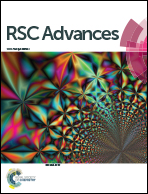High sensitivity, fast response and low operating voltage organic photodetectors by incorporating a water/alcohol soluble conjugated polymer anode buffer layer
Abstract
Low dark current density plays a key role in determining the overall performance of organic photodetectors (OPDs). However, both the donor domains and acceptor domains in the bulk heterojunction, which has high exciton dissociation efficiency, are in contact with the two electrodes. Therefore, the undesirable charge injection from the electrodes to the active layer is hard to avoid, leading to a high dark current density in most OPDs. In this work, we fabricate the OPDs based on a conventional poly(3-hexylthiophene) (P3HT)/(phenyl-C61-butyric-acid-methyl-ester) (PC61BM) bulk heterojunction. By incorporating a water/alcohol soluble conjugated polymer (WSCP), poly[(9,9-bis(3′-(N,N-dimethylamino)propyl)-2,7-fluorene)-alt-2,7-(9,9-dioctylfluorene)] (PFN), interlayer between the anode and the active layer, the dark current density is effectively reduced from 0.07 mA cm−2 to 1.92 × 10−5 mA cm−2 under a −0.5 V bias. The resulting OPDs show a 1.93 × 105 signal-to-noise ratio (SNR), a 10 MHz bandwidth, and a 9.10 × 1012 Jones detectivity at a low reverse bias of −0.5 V (at 550 nm). Our research provides a promising way for high performance OPDs.



 Please wait while we load your content...
Please wait while we load your content...